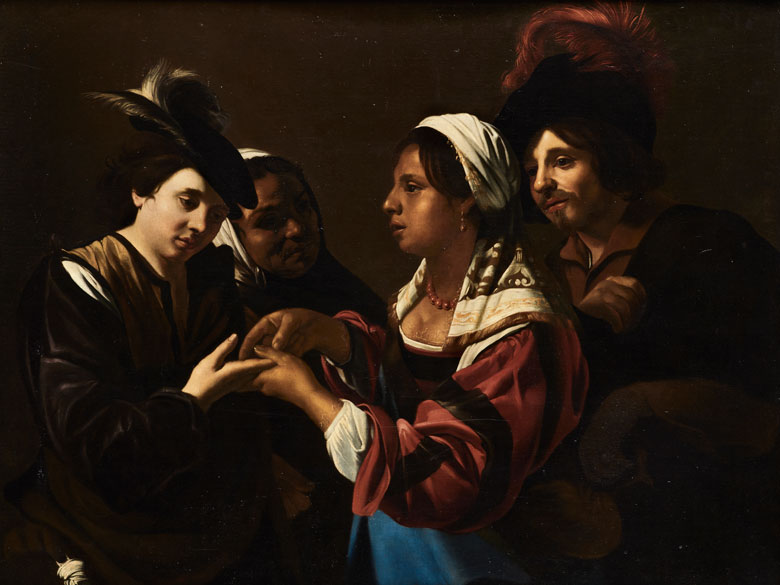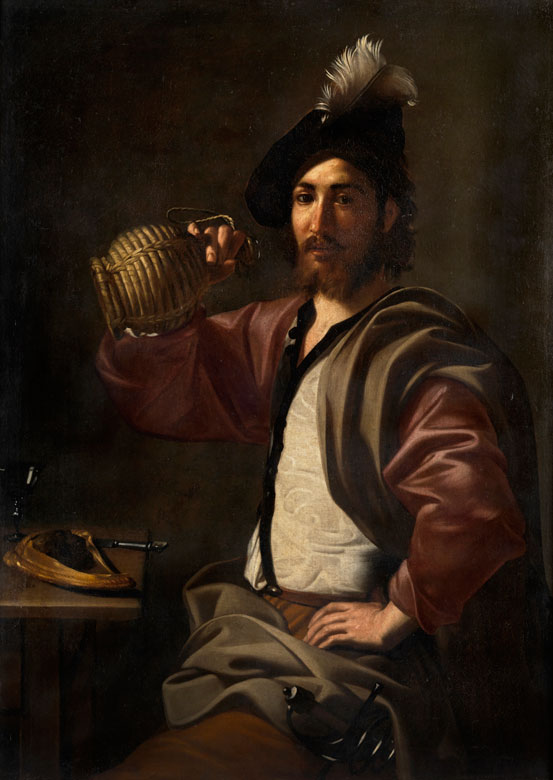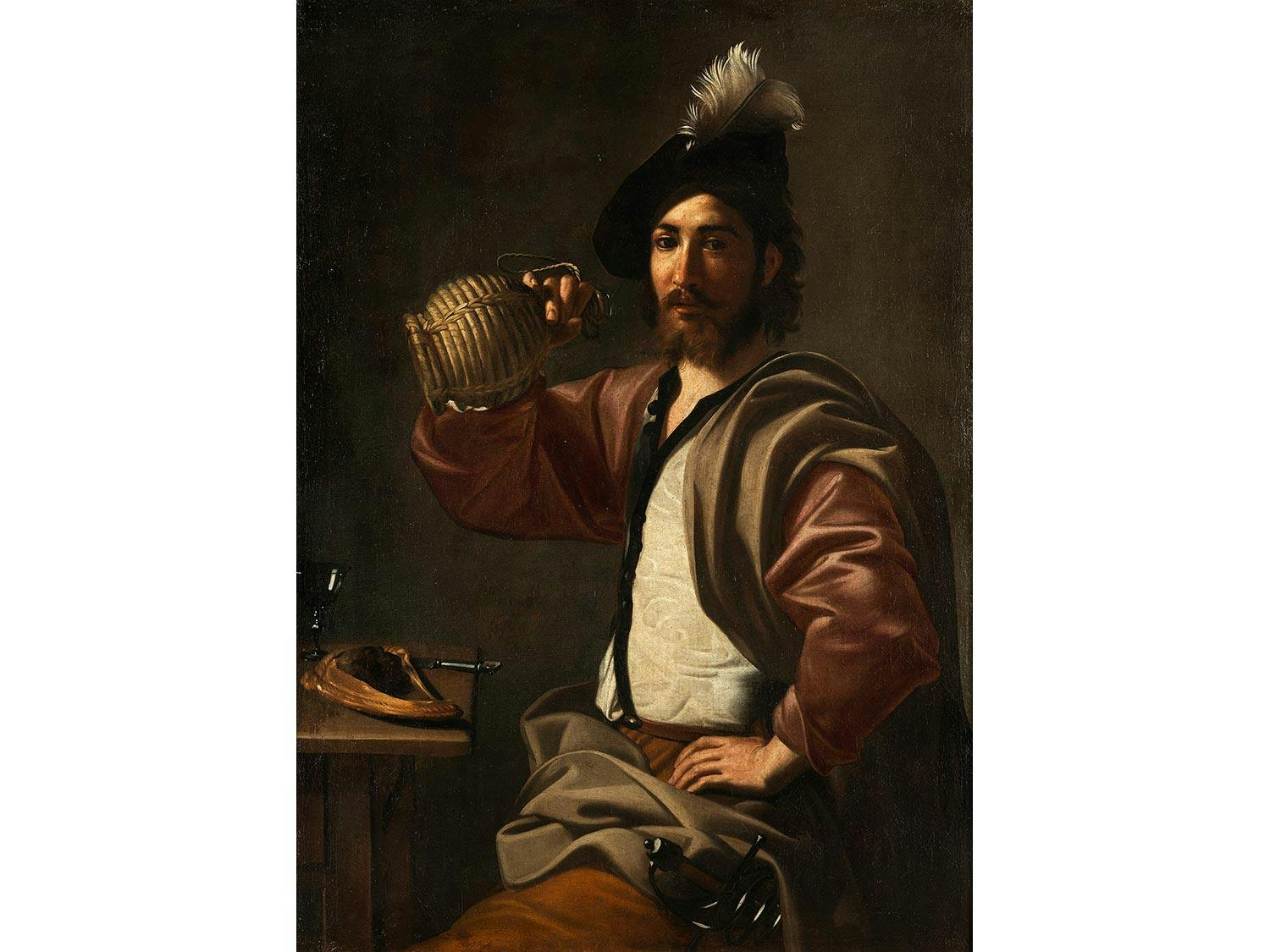Nicolas TournierJoseph and Potiphar's Wife Oil on canvas, unframed94 x 131 cm ; 37 by 51⅝ in. ____________________________________________ Nicolas TournierJoseph et la femme de Putiphar Huile sur toile, sans cadre94 x 131 cm ; 37 by 51⅝ in.Condition reportFor further information on the condition of this lot please contact clemence.enriquez@sothebys.com ProvenanceAnonymous sale, Lempertz, Cologne, 14 November 1963, lot 64 (as Bartolomeo Manfredi .____________________________________________ Vente anonyme, Lempertz, Cologne, 14 novembre 1963, lot 64 (comme Bartolomeo Manfredi .LiteratureB. Nicolson, Caravaggism in Europe, Oxford 1979, vol. I, p. 197 and vol. II, fig. 615 (as Tournier);A. Hémery in cat. exh. Nicolas Tournier 1590-1639 : un peintre caravagesque, Toulouse, Musée des Augustins, 2001, p. 174 (considers the painting as probably Italian);E. Ullrich, Das Laszive der Keuschheit in der europäischen Kunst: Die Frau des Potiphar und Joseph von Ägypten - Eine Kulturgeschichte der versuchten Verführung, Kassel 2009, Kat. 159, p. 386 (as by Caracciolo).____________________________________________ B. Nicolson, Caravaggism in Europe, Oxford, 1979, vol. I, p. 197 et vol. II, fig. 615 (comme de Tournier) ;A. Hémery dans cat. exp. Nicolas Tournier 1590-1639 : un peintre caravagesque, Toulouse, Musée des Augustins, 2001, p. 174 (considère le tableau comme probablement italien) ;E. Ullrich, Das Laszive der Keuschheit in der europäischen Kunst: Die Frau des Potiphar und Joseph von Ägypten - Eine Kulturgeschichte der versuchten Verführung, Kassel, 2009, Kat. 159, p. 386 (comme de Caracciolo).Catalogue noteWhen it was sold in 1963, this painting was thought to be by Manfredi, but it was rightly reassigned to Nicolas Tournier by Benedict Nicolson in 1979. Born in Montbéliard, into a Protestant family who had fled Besançon, it seems likely that Nicolas Tournier initially trained within his family circle, since his father and uncle were both painters. He moved to Rome in 1619 – when he is first documented in the Eternal City – following in the footsteps of Nicolas Régnier and Valentin de Boulogne Close to Bartolomeo Manfredi to the point where their works are often confused, as in the case of the present painting, Tournier soon established himself as one of the leaders of the French Caravaggesque movement. He left Rome in 1626 and returned to France: to Carcassonne in 1627, and then to Toulouse from 1632. His art now evolved towards a deliberate simplification and more abstract volumes: his French works can therefore be clearly distinguished from his first Italian canvases. Close to the art of Manfredi and with a very Roman sensuality – from which Tournier would later turn away to embrace a dryer style – Joseph and the wife of Potiphar should certainly be dated to the artist’s time in Rome. The painting can also be compared to other works that the young French painter produced while in Italy, particularly Young Woman Offering a Rose to a Singer, formerly in the Koelliker collection (sale Christie's Online, New York, 20 October 2020, lot 78), both for the pictorial treatment of the skin tones and fabrics, especially the opulent red satin of Joseph’s sleeves, and for the physical type of the two protagonists, who seem to be the same young models in both compositions. Likewise, there are notable affinities with the Concert in the Musée du Berry (inv. 1956.37.1), while in terms of the young Joseph’s physical type there are similarities to the St John the Evangelist in the Spada Gallery and the Lute Player in the Hermitage Museum in St Petersburg (inv. Э-5568). Finally, the profile of Potiphar’s wife strongly recalls the profiles of the young women on the left of the Sinite Parvulos in the Galleria Corsini in Rome (inv. 406) and in Tobias and the Angel in the Schorr collection, as well as – in terms of the physical type and hairstyle – St Peter’s accuser in the Denial of St Peter in the Museo del Prado (inv. 2788). _________________________
Nicolas TournierJoseph and Potiphar's Wife Oil on canvas, unframed94 x 131 cm ; 37 by 51⅝ in. ____________________________________________ Nicolas TournierJoseph et la femme de Putiphar Huile sur toile, sans cadre94 x 131 cm ; 37 by 51⅝ in.Condition reportFor further information on the condition of this lot please contact clemence.enriquez@sothebys.com ProvenanceAnonymous sale, Lempertz, Cologne, 14 November 1963, lot 64 (as Bartolomeo Manfredi .____________________________________________ Vente anonyme, Lempertz, Cologne, 14 novembre 1963, lot 64 (comme Bartolomeo Manfredi .LiteratureB. Nicolson, Caravaggism in Europe, Oxford 1979, vol. I, p. 197 and vol. II, fig. 615 (as Tournier);A. Hémery in cat. exh. Nicolas Tournier 1590-1639 : un peintre caravagesque, Toulouse, Musée des Augustins, 2001, p. 174 (considers the painting as probably Italian);E. Ullrich, Das Laszive der Keuschheit in der europäischen Kunst: Die Frau des Potiphar und Joseph von Ägypten - Eine Kulturgeschichte der versuchten Verführung, Kassel 2009, Kat. 159, p. 386 (as by Caracciolo).____________________________________________ B. Nicolson, Caravaggism in Europe, Oxford, 1979, vol. I, p. 197 et vol. II, fig. 615 (comme de Tournier) ;A. Hémery dans cat. exp. Nicolas Tournier 1590-1639 : un peintre caravagesque, Toulouse, Musée des Augustins, 2001, p. 174 (considère le tableau comme probablement italien) ;E. Ullrich, Das Laszive der Keuschheit in der europäischen Kunst: Die Frau des Potiphar und Joseph von Ägypten - Eine Kulturgeschichte der versuchten Verführung, Kassel, 2009, Kat. 159, p. 386 (comme de Caracciolo).Catalogue noteWhen it was sold in 1963, this painting was thought to be by Manfredi, but it was rightly reassigned to Nicolas Tournier by Benedict Nicolson in 1979. Born in Montbéliard, into a Protestant family who had fled Besançon, it seems likely that Nicolas Tournier initially trained within his family circle, since his father and uncle were both painters. He moved to Rome in 1619 – when he is first documented in the Eternal City – following in the footsteps of Nicolas Régnier and Valentin de Boulogne Close to Bartolomeo Manfredi to the point where their works are often confused, as in the case of the present painting, Tournier soon established himself as one of the leaders of the French Caravaggesque movement. He left Rome in 1626 and returned to France: to Carcassonne in 1627, and then to Toulouse from 1632. His art now evolved towards a deliberate simplification and more abstract volumes: his French works can therefore be clearly distinguished from his first Italian canvases. Close to the art of Manfredi and with a very Roman sensuality – from which Tournier would later turn away to embrace a dryer style – Joseph and the wife of Potiphar should certainly be dated to the artist’s time in Rome. The painting can also be compared to other works that the young French painter produced while in Italy, particularly Young Woman Offering a Rose to a Singer, formerly in the Koelliker collection (sale Christie's Online, New York, 20 October 2020, lot 78), both for the pictorial treatment of the skin tones and fabrics, especially the opulent red satin of Joseph’s sleeves, and for the physical type of the two protagonists, who seem to be the same young models in both compositions. Likewise, there are notable affinities with the Concert in the Musée du Berry (inv. 1956.37.1), while in terms of the young Joseph’s physical type there are similarities to the St John the Evangelist in the Spada Gallery and the Lute Player in the Hermitage Museum in St Petersburg (inv. Э-5568). Finally, the profile of Potiphar’s wife strongly recalls the profiles of the young women on the left of the Sinite Parvulos in the Galleria Corsini in Rome (inv. 406) and in Tobias and the Angel in the Schorr collection, as well as – in terms of the physical type and hairstyle – St Peter’s accuser in the Denial of St Peter in the Museo del Prado (inv. 2788). _________________________













Testen Sie LotSearch und seine Premium-Features 7 Tage - ohne Kosten!
Lassen Sie sich automatisch über neue Objekte in kommenden Auktionen benachrichtigen.
Suchauftrag anlegen